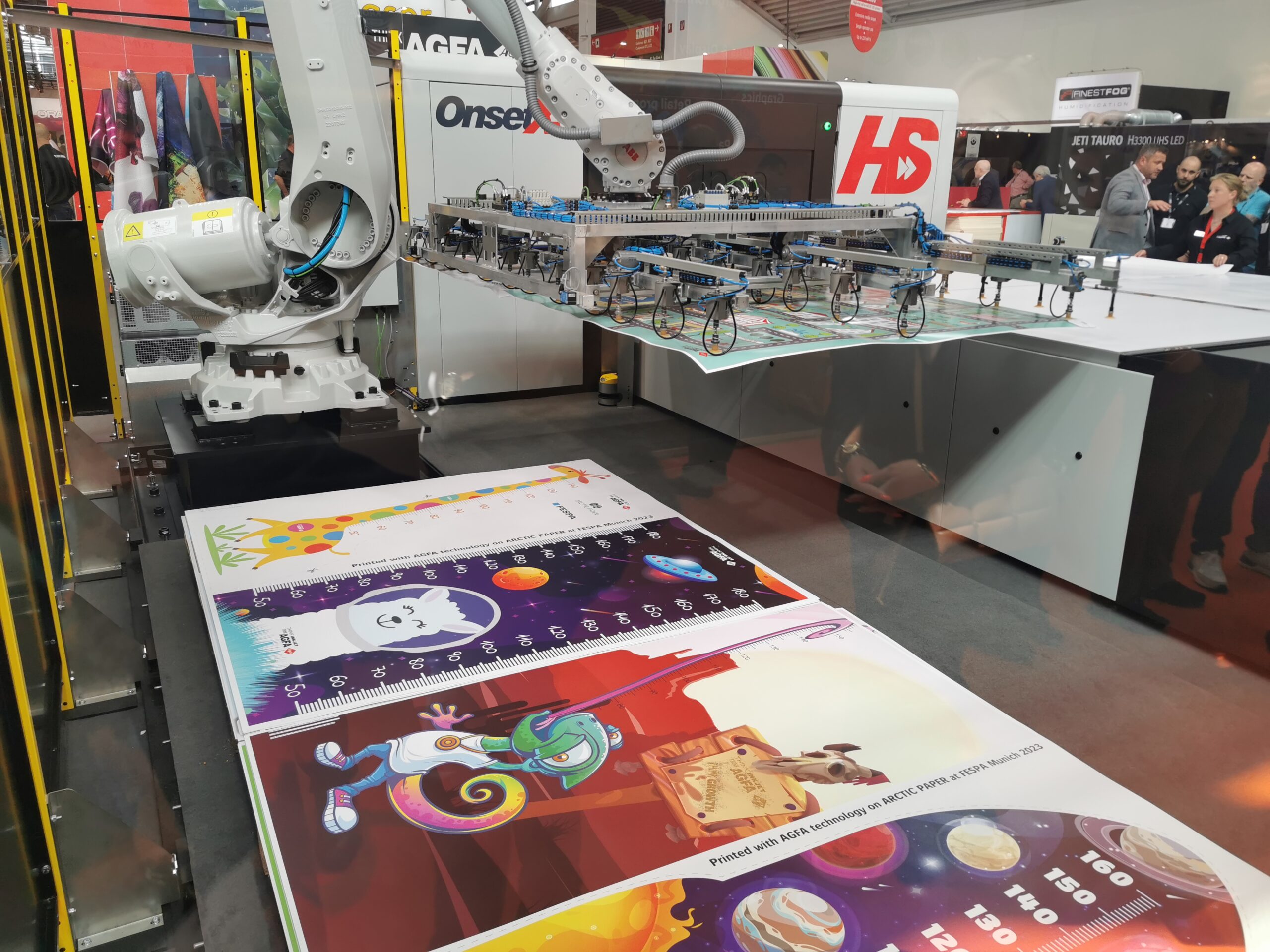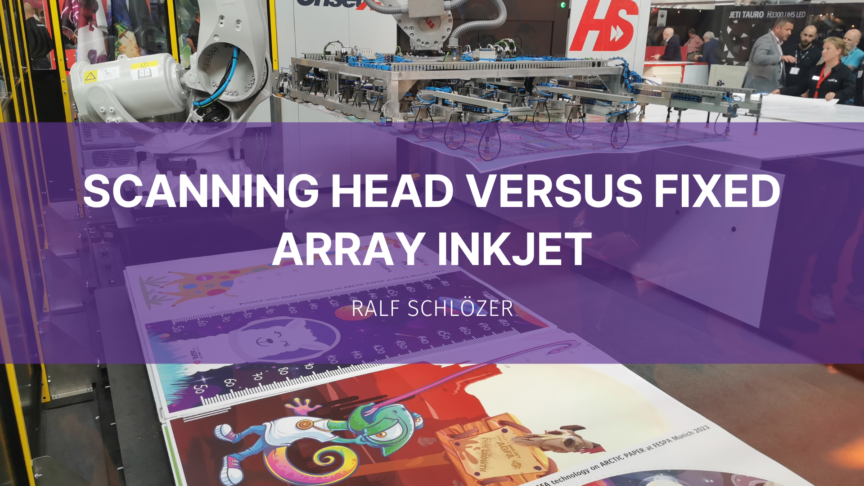If Hunkeler innovationdays is the Olympics of the single-pass inkjet continuous feed presses, FESPA* is the championship of the scanning head (large format) inkjet printers. At FESPA 2023 in Munich, more than four halls of exhibits demonstrated the wide choice of scanning head inkjet printing available. All combined this makes a bewildering choice for users. At Inkjet Insight we tend to focus on single-pass inkjet but scanning head inkjet might be a good fit for some application needs as well.
Comparing scanning-head versus single-pass
The most obvious difference between single-pass and scanning head (also called multi-pass, although not always strictly accurate) is the throughput. In scanning head printers the printhead assembly travels the width of the media before the head or media is advanced. This takes more time than having a media forwarded under an array of stationary page-wide heads. Scanning heads allow for a much lower number of inkjet heads for a given width, resulting in lower price hardware. Taking it to the extreme, it also allows for much wider widths than what could be economically achieved with single-pass heads.
In many cases, the application requirements clearly point to one of these technologies. High-volume document printing requires single-pass print, while widths of 2 metres and more require large format scanning-head printers. However, there can be some overlap in certain cases.
FESPA 2023 proved a good opportunity to get an overview of the current status of the scanning head market. While there is a lot of choice in entry and mid-market models, high-volume devices are scarce.
Several device categories exist with aqueous ink printers aimed at poster and billboard printing, while UV-inkjet printers are catering for a variety of substrates which usually excludes papers. Roll-to-roll devices print on flexible substrates while sheet-to-sheet printers print on rigid substrates like boards. Occasionally on printers the feeding mode can be switched, then termed hybrid printers. The table below lists a selection of the current highest speed scanning head printers.
Selected top speed scanning head printers
|
OEM |
Aleph |
Agfa/Inca |
Agfa |
Durst |
EFI |
EFI |
Fujifilm |
MS printing solutions |
|
Model |
Laforte 600 |
Onset X3 HS |
Tauro H3300 UHS LED |
P5 HSR |
Vutek XT |
Vutek PaperPro |
Acuity Ultra R2 |
JPK Evo |
|
Max sqm/hr |
1000 |
1449 |
905 |
670 |
1115 |
585 |
600 |
825 |
|
Ink type |
Aqueous |
UV |
LED UV |
LED UV |
LED UV |
Aqueous |
LED UV |
Aq |
|
Max print width (m) |
1,8 |
1,6 x 3,2 |
3,3 |
3,5 |
1,6 |
1,85 |
5 |
3,2 |
|
Transport |
roll-to-roll |
sheet-to.-sheet |
hybrid |
roll-to-roll |
hybrid |
roll-to-roll |
roll-to-roll |
roll-to-roll |
As high-end scanning-head printers constantly get faster, it is an interesting exercise to compare them to single-pass printers in terms of output speed. As print speed for wide format printers is usually quoted in square-metre per hour the output of single-pass printers has been converted into the same metric in the chart below. It is assumed that the full printable format is being used, which is not always the case for single-pass printers. There is a wide choice of 2-up webfed printers available. To slim down the chart, two exemplary speeds have been picked at 150 m/min and 100 m/min – speeds that are reached by several models in high-quality modes. There are also 4-up printers (and even wider ones) and their productivity would be totally off the scale and therefore are not displayed below. Sheetfed models tend to be slower, with the exception of the Landa S10 being noticeably ahead.

Comparison print speed: Scanning head vs single-pass inkjet
Even if speeds are sufficient, it will be challenging to produce large amounts of smaller format products on a large format printer, even if a smaller format equates to a B2 or B1 sheet. There are scanning head models, however, that would better bridge the gap for smaller volumes e.g. in B1. For example, the Fujifilm Acuity B1 offers up to 120 B1 sheets/hour or up to 200 B1 sheets/hour when using double banks for CMYK heads. The latter translates into 150 sqm/hour, which would not place it in the top productivity group of large format printers, however.
Is the maximum speed realistic?
The big caveat in speed is the infamous “up-to” disclaimer when comparing speeds. With a printer being able to reach that speed, it is not guaranteed that widely sellable products can be produced at that speed.
There can be a number of limiting factors which prevent users from reaching the maximum speed and productivity.
- Time for loading and unloading media, especially sheets
- Print quality
- Drying capacity
In most cases, the print quality is a limiting factor. Typically, a quarter or third of the maximum quoted speed will be used for the qualities required in the market. Exceptions exist; therefore it pays to investigate speed and quality settings in detail. Vendor terms for settings like “quality” “production”, “draft” or “express“ mode are not well defined. It should be kept in mind that high-speed settings in single-pass and scanning head printers will have different effects. In single-pass printers a higher speed results in a reduction of resolution in web direction and a somewhat reduced density. For scanning head printers this is less clear cut. Sometimes the imaging resolution remains high, but appearance (quality) suffers noticeably – more so than for sing-pass printers. Reducing the number of passes often results in a much lower density, graininess, and stepping artifacts in lines. Also, gloss levels can be affected. Deducting a mainstream production speed from the maximum speed can be tricky. Some devices have a minimum of two passes for the maximum speed, while for others the top speed is based on one pass only.
More than productivity
There is more than productivity to consider when comparing single pass and scanning head printers. Large format printers only print single-sided output while the vast majority of single-pass printers are duplexing capable. Large format printers are more flexible in terms of substrates by type and thickness. Partially this is due to the ink system with UV being more versatile. Moreover, substrate forwarding and inkjet head positioning in scanning head systems allow for more substrate types.

Inca Onset with robotics at Agfa booth at FESPA 2023
Large format printers increasing in speed will broaden the choices for print service providers. Advances in robotics, as seen at FESPA 2023, will drive productivity in addition. Another sign of large format vendors closing the gap are the latest announcements to move or expand into singe-pass printers. While EFI is already established in single-pass inkjet, the Nozomi 14000 SD equipped for the display market will offer a lower priced entry into single-pass display print and is set to cost under €2 million. Fujifilm’s large format division is planning its first entry into single-pass display print through a cooperation with Barberan. The HS6000 was announced at FESPA, with its first installations to happen within one year. It is targeted at users of multiple Inca Onset printers to consolidate volume and move into even higher productivity.
We have certainly not seen the end of developments, where the markets of high-productivity large format starts to overlap into single-pass markets.
* The Federation of European Screen Printing Associations – FESPA

